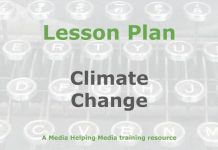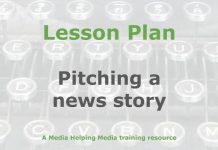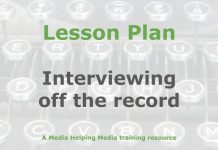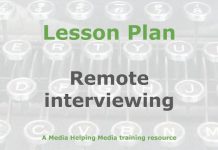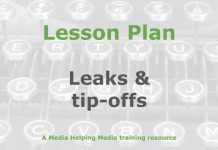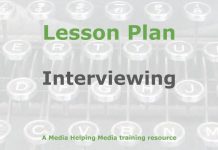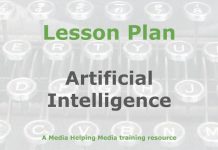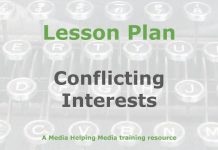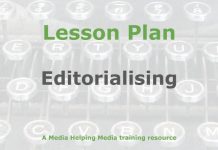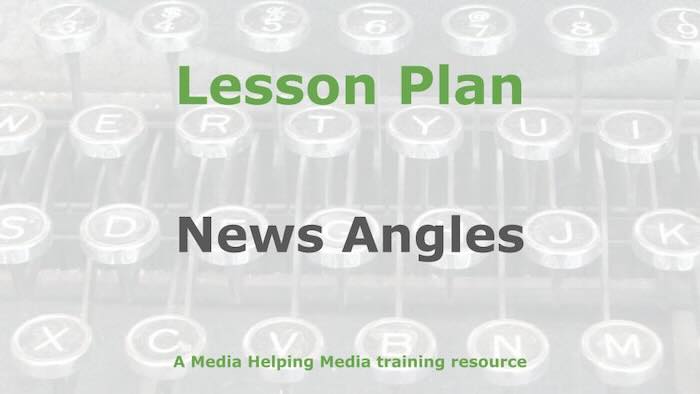 This lesson plan is designed to help trainers teach students how to seek out new angles on a breaking, developing or running news story.
This lesson plan is designed to help trainers teach students how to seek out new angles on a breaking, developing or running news story.
It’s based on the article ‘How to develop important news angles‘ which we recommend you read before adapting this training outline for your own purposes.
Learning objective
Students will identify and analyse new angles in news stories in order to add context and depth. They will evaluate the implications of these angles on the audience and the broader news narrative.
- Student-facing objective: By the end of this lesson the student will be able to find and explain new angles in news stories that make them more informative and relevant to the audience.
- Standards: A student will understand how to develop a news story in ways that reveal important new angles that add context.
Learning activities
Warm-up
Show students a brief news clip or article headline. Ask them to jot down their initial thoughts on the main angle of the story. Then, prompt them to consider alternative angles by asking: “What other perspectives or impacts could this story have?” Encourage sharing in pairs, then select a few students to share with the class. This primes students to think critically about news angles and prepares them for deeper analysis.
Direct instruction
Introduce the concept of news angles: Begin by explaining the importance of identifying new angles in news stories. Use a real-world example, such as a recent news event. Discuss how different angles can provide varied insights. Highlight how these angles can affect audience perception and understanding.
Analyse a news story: Present a news article with a clear main angle. Break down the article with the class, identifying the primary angle and discussing its implications. Ask students to brainstorm potential alternative angles, considering factors such as audience impact and broader context. Facilitate a discussion on how these angles could change the narrative.
Explore the editorial process: Describe how journalists and editorial teams decide which angles to pursue. Use a hypothetical news meeting scenario where students role-play as editorial staff. Assign roles and have them discuss a breaking news story, debating which angles are most important to investigate further. Guide them to consider audience impact and ethical considerations.
Guided practice
Think, Pair, Share: Guide students through a structured analysis of a news story to identify new angles.
Think: Present a news article with a clear main angle. Ask students to individually identify and jot down potential new angles that could add depth or context to the story.
- Pair: Have students pair up to discuss their identified angles. Encourage them to explain their reasoning and consider their partner’s perspectives.
- Share: Facilitate a class discussion where pairs share their findings. Highlight diverse angles and discuss their potential impact on audience understanding.
- Connect: Encourage students to connect these angles to broader societal issues or trends. Discuss how these connections can enhance the story’s relevance.
- Reflect: Ask students to reflect on how identifying new angles can change the narrative and influence public perception. Encourage them to consider the journalist’s role in shaping these narratives.
Independent practice
- Exercise: Provide students with a news article. Instruct them to independently identify at least three new angles that could add depth or context. Encourage them to consider audience impact and broader societal implications.
- Analysis: Have students write a brief analysis of one identified angle, explaining its potential impact on the audience and how it could alter the narrative.
- Peer review: Pair students to exchange their analyses. Each student should provide constructive feedback on their partner’s identified angles and analysis. Encourage them to suggest additional angles or considerations.
Circulate to observe and support students as needed.
Assignment
Ask students to answer these questions:
- What is one new angle you identified in today’s news story that could add depth or context?
- How might this new angle affect the audience’s understanding of the story?
- What’s one question you still have from today’s lesson?
Here are some suggested answers:
- Suggested answer to Question 1: A new angle could be the economic impact of the event on local businesses.
- Suggested answer to Question 2: This angle might help the audience understand the broader economic implications and how it affects their community.
Teacher resources
Differentiation guide
- Advanced learners: Encourage deeper analysis by having them explore complex societal implications of news angles. Assign them to identify and critique the ethical considerations in choosing certain angles over others. Challenge them to propose alternative narratives and justify their choices.
- Striving learners: Simplify tasks by providing structured templates for identifying news angles. Use guided questions to help them focus on the main aspects of a story. Pair them with peers for collaborative analysis to build confidence and understanding. Offer additional examples to illustrate how different angles can change a story’s impact.
- Background reading: This lesson plan is based on the article ‘How to develop important news angles‘ which we recommend you read before adapting this training outline for your own purposes.
Notable definitions
- News angle: A specific perspective or approach to a news story that highlights particular aspects, providing depth and context to the audience.
- Editorial process: The series of discussions and decisions made by journalists and editors to determine which news angles to pursue and how to present them.
- Audience impact: The effect that a news story or angle has on the audience’s understanding, perception, and engagement with the topic.
Required materials
- News articles or clips for analysis
- Notebooks or digital devices for note-taking
- Access to online news sources
- Printed or digital copies of a news article for independent practice
- Peer review guidelines document
- Analysis template document
Lesson summary
- Warm-up
- Direct instruction
- Guided practice
- Independent practice
- Assignment
The free teaching tools at the Khan Academy were used in the production of this lesson plan.
Related articles
